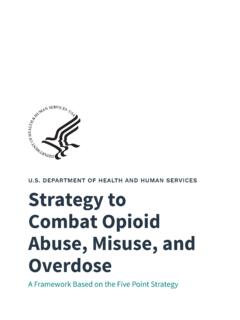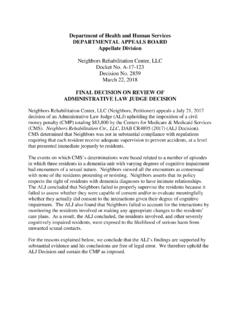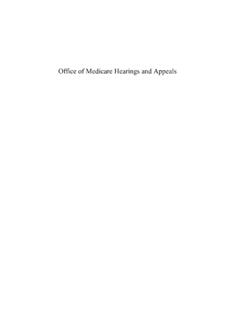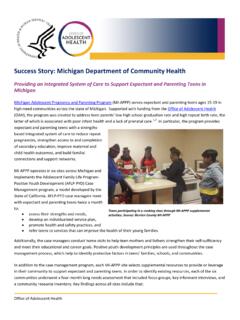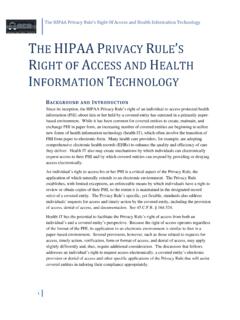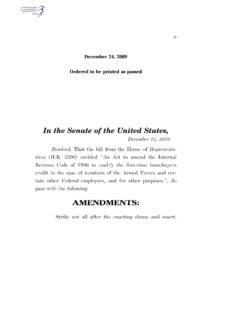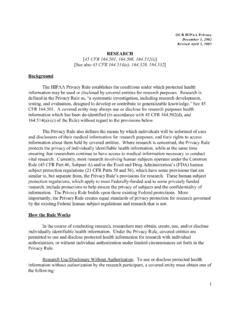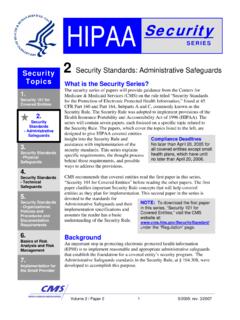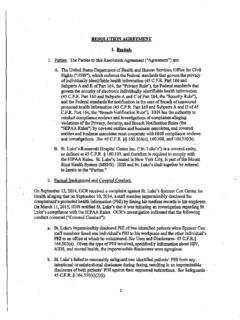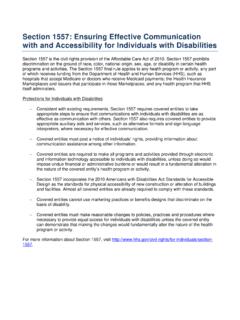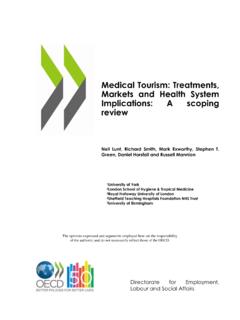Transcription of Affordable Care Act and Immunizations: Health Plan ...
1 1 Affordable Care Act and Immunizations: Health Plan Perspectives National Vaccine Advisory Committee February 5, 2013 Scott Breidbart, MD Chief Medical Officer, Empire Blue Cross Blue Shield On behalf of AHIP 2 Plan s Long-standing Commitment to Vaccine Coverage and Performance Measures Patient Protection and Affordable Care Act Activities & Opportunities 3 Presentation Overview Health Plans Commitment to Vaccinating All Populations 4 Coverage of ACIP-recommended Vaccines before the ACA, Health plans were committed to promoting recommended vaccines in all populations, and were supportive of the ACA provision that all new Health plans are required to provide first-dollar coverage for all ACIP- recommended routine vaccines. 2. High-deductible Health plans have typically provided first dollar coverage. 3. Plans often reimburse non-traditional providers such as pharmacies, retail clinics, etc.
2 To increase accessibility and vaccination rates. 4. AHIP and its member plans are partnering with CDC and ASTHO (Association of State and Territorial Health Officials) to educate and assist in building infrastructure for public Health departments and pharmacies obtaining reimbursement from Health plans for providing vaccines to insured individuals. 5. AHIP continually disseminates and promotes best practices for increasing vaccination rates among its member plans. 5 AHIP s 2008 Immunization Survey highlights improvements over time. of commercial enrollees were enrolled in a plan that based immunization coverage on ACIP recommendations in 2008. of plans in 2008 took 3 months or less to make a decision to cover new ACIP recommended vaccines ( in 2005). Timeframes for both inclusion of vaccines in benefit design and provider reimbursement after vaccine inclusion in benefit design have decreased substantially (improved) since 2005.
3 Continuous Quality Improvement 6 track specific measures to obtain and maintain accreditation, meet certain regulatory requirements, and improve quality of care. and CAHPS are the most commonly used measure sets by Health plans to measure quality and performance on care and services . may incorporate and/or modify additional measures from other nationally recognized sources. HEDIS stands for Healthcare Effectiveness Data and Information Set and is a tool used by America's Health plans to measure performance on important dimensions of care and service. The Consumer Assessment of Healthcare Providers and Systems (CAHPS) program is a multi- year initiative of the Agency for Healthcare Research and Quality (AHRQ) to support and promote the assessment of consumers' experiences with Health care. The Importance of Nationally Recognized Quality and Performance Metrics 7 The Importance of Nationally Recognized Quality and Performance Metrics Health plans are committed to continually improving their quality metrics in all areas including immunization.
4 As people begin purchasing insurance through state and federal exchanges, performance measures will be even more important for plans to be able to compete for business. 8 Examples of Measures Routinely Monitored by Health Plans Childhood Immunization Status (HEDIS) Measures children who have received the ACIP-recommended immunizations by their second birthday, including influenza and pneumococcal vaccines. Flu Shots for Adults Ages 50 and Over (CAHPS, PCPI) Pneumonia Vaccination Status for Oder Adults (CAHPS, PCPI) Influenza Vaccination: Management of People with CAD/CHF/HTN (NCQA Disease Management measure) Pneumococcal Vaccination: Management of People with CAD/CHF/HTN (NCQA Disease Management measure) Influenza Vaccination: Management of People with Diabetes (NCQA Disease Management measure) Pneumococcal Vaccination: Management of People with ASTHMA/ COPD (NCQA Disease Management measure) Influenza Vaccination: Management of People with Asthma/COPD.
5 (NCQA Disease Management measure) Pneumonia Patients Aged 65 and Older Screened for Pneumococcal Vaccine Status and Administered Vaccine Prior to Discharge (CMS measure) Pneumonia Patients Aged 50 and Older Screened for Influenza Vaccine Status and Vaccinated Prior to Discharge (CMS Measure) 9 The Patient Protection and Affordable Care Act (ACA) 10 Preventive services and the Affordable Care Act 11 New Health plans (non grandfathered plans) required to cover all ACIP-recommended routine vaccines beginning 2010. Coverage of ACIP-recommended routine vaccines within one year of adoption. No cost sharing for recommended clinical preventive services , including immunizations recommended by ACIP. Coverage with no cost-sharing for recommendations set forth by the USPSTF given a A or B rating. Evidence-informed preventive care and screenings for women, children and adolescents as guided by the HRSA ACIP Advisory Committee on Immunization Practices USPSTF Preventive services Task Force HRSA Health Resources and services Administration Current Activities & Opportunities 12 AHIP and Health Plan Activities to Encourage Vaccines 13 AHIP has a seat as non-voting liaison representative to both NVAC and the ACIP.
6 NQF Member Plans Workgroup AHIP s National Quality Forum member plans provide feedback on NQF reports and nominations. AHIP Member Plan Workgroups: comprised of member plan Medical Directors, and other program/quality improvement representatives. Quality and Industry Standards Workgroup: Discuss and exchange solutions, ideas and opinions on issues related to performance measurement and quality standards; provide feedback on proposed standards , regulations, and recommendations. Prevention and Population Health Workgroup: Share best practices to improve overall utilization of preventive services , provide input on perspective of the industry to national prevention- and immunization-related policy advisory groups on a variety of issues. 14 Participates with Partner Organizations : AHIP periodically hosts forums for member plans and stakeholders to meet.
7 Immunization Surveys: survey of member Health plans to identify immunization practices and policies. Recognition Programs - AHIP member plans are recognized for improving immunization rates across populations. and Web Sites on Effective Immunization Strategies and Innovations. 15 Health Plans Work Together and With Stakeholders to Improve Vaccine Rates 2008: NVAC released recommendations on vaccine financing for childhood and adolescent vaccines. 2010: AHIP and the CDC s National Center for Immunization and Respiratory Diseases began working collaboratively on the Public Health Billing Infrastructure project to provide training to public Health entities on contracting with Health plans for immunization services . 16 AHIP Training for Public Health Agencies To view AHIP s archived trainings and resources for public Health agencies, go to: 17 Assisting Public Health Agencies with Third-party Billing To view AHIP s archived trainings and resources for public Health agencies, go to.
8 April 13, 2010 Health Insurance 101 July 28, 2011 Understanding Health Plan Reimbursement Policies for Immunization services February 1, 2012 Stakeholder Meeting for Public Health Agencies February 21, 2012 Contracting with Health Plans An Overview June 26, 2012 AHIP s Commitment to the CDC Billing Project July 18, 2012 Strategies for Contracting with Health Plans for Vaccine Delivery August 22, 2012 Vaccine Coding and Electronic Billing September 19, 2012 Other Issues in Establishing a Vaccine Billing Infrastructure (overview of strategies, credentialing, FAQs) Through its various presentations and webinar sessions, AHIP has: participating public Health department agencies with best practices and resources for working to contract with Health plans for immunization services participants with contacts within the Health plans the variability that exists within states and Health plans related to contracting.
9 Participants on best practices and available resources for coding for vaccines and immunization services various claims submission mechanisms and credentialing requirements for public Health agencies providing vaccines. to FAQs about Health insurance coverage and reimbursement 18 To view AHIP s archived trainings and resources for public Health agencies, go to: Assisting Public Health Agencies with Third-party Billing cont d. Impact of Vaccination: Reduced Mortality and Cost-Savings 19 Overview of Issues in Immunization Immunization rates are higher for persons with insurance1; more people will enter the insurance system in 2014. Well child visits are well established. Adults visit primary care physicians less often for preventive care. Children have certain immunization requirements (state) for school, other requirements for daycare and college; adults do not have such requirements.
10 20 1. Cotter J. Napa Immunization Study: Immunization Rates for Children with Publicly Funded Insurance Compared with Those with Private Health Insurance in a Suburban Medical Office. 2011. The Permanente Journal, v. 15:4. Overview of Issues in Immunization Education and awareness around new vaccine recommendations are needed. Myths around vaccine safety continue and messaging around vaccine safety issues need to continue to evolve. Changing payment and delivery models such as evolution of Accountable Care Organizations (ACOs) and Patient Centered Medical Homes (PCMHs) will provide further incentives to vaccinate recommended populations. There is an increase in community-wide efforts to focus on gap areas, resources, energy and common goals especially among adult immunization measures. 21 Thank you. Questions? 22
